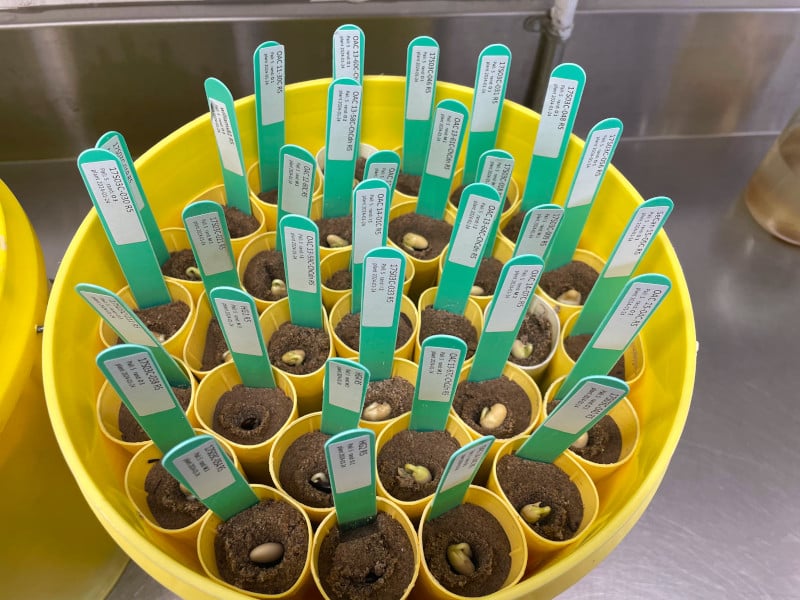When it comes to wheat midge, soybean cyst nematode and root rot in pulses, researchers are staying ahead of the enemy.
Imagine you’re a tiny wheat midge, buzzing around in search of the perfect place to lay your eggs. As you fly over a wheat field, you pick up scents with your delicate antennae. These scents, or volatile organic chemicals, tell you a lot about the wheat plants below.

Some wheat emits odors that just don’t appeal to you — they’re like a poorly mixed sound equalizer, with ratios of chemicals that don’t quite hit the mark. When the ratios are right, though, it’s like a perfect harmony to your senses. These plants smell inviting, and you’re drawn to lay your eggs there.
Scientists have discovered that some wheat varieties naturally deter you from laying eggs. It’s not about taste, but smell. These plants release volatiles that mimic those found in post-anthesis wheat, a stage wheat goes through that makes it hard for insect larvae to survive.
So, even if the wheat is at a pre-anthesis stage, optimal for your larvae’s survival, its smell tells you otherwise.
It’s like a clever trick — a plant defense strategy called oviposition deterrence. Just like any caring parent, you avoid wasting your eggs on plants that won’t support your offspring well.
“Understanding these volatile cues isn’t easy — it took scientists years of collecting air samples from wheat fields to decipher which chemicals deterred midge and which didn’t. Now, armed with this knowledge, we can better understand how plants defend themselves and how insects like wheat midge respond to their environment,” says Tyler Wist, entomologist with Agriculture and Agri-Food Canada (AAFC) in Saskatoon, Sask.
Wist’s team is uncovering new traits and genes that protect wheat from destructive pests like wheat midge. They’ve identified a novel QTL region enhancing the efficacy of the Sm1 gene, along with other genetic regions altering wheat’s scent to make it less appealing to wheat midge.
It’s tools like this that represent a new weapon in the fight against pests and disease in crops.
“When you consider the pulse industry, there’s a well-established network where information flows easily throughout the entire value chain. It’s not just about producers; it also involves seed commercializing organizations coming together to develop policies, strategies, and priorities,” says Sabine Banniza, pulse pathologist at the University of Saskatchewan’s Crop Development Centre (CDC).
Banniza’s pathology program, like Wist’s team, is also actively looking at the genetics inherent in pulses like pea and lentil to create new defenses against Aphanomyces root rot.
It thrives in wet, warm conditions and has expanded across the province, causing up to 60–84% yield declines in pea and lentil with losses in sales and exports of up to $1.5 billion a year, according to the Saskatchewan Pulse Growers (SPG).
Currently, a few specific practices or products can manage Aphanomyces, one of the most harmful pathogens in the root rot complex affecting pulses. The primary strategy for controlling it involves long-term crop rotations, avoiding peas or lentils for six to eight years or more. That’s a long time to totally stop growing a specific crop, she notes.
A project she’s spearheading at the CDC recently received more than $4.2 million from the Strategic Research Initiative (SRI) to discover and develop solutions for root rot in pea and lentil crops.
Her team will investigate biocontrol and other market products to see if combining them with the first generation of varieties with improved resistance can provide short-term solutions for farmers, but they’re also delving into the genome to find a new approach to protecting crops using RNAi fungicides. This innovative method could offer a novel way to enhance crop protection.
RNA is a fundamental molecule present in all living organisms. It plays a crucial role in translating genetic information into proteins, which are the building blocks for enzymes, structures, and various other components essential for life.
“Traditionally, we protect plants by breeding resistance into seeds or applying seed treatments and fungicides. This is akin to defending against an invasion where the pathogen, like an enemy, uses weapons produced in its factories to bombard the plant. RNA interference (RNAi) offers a different strategy,” Banniza says.
Think of RNAi as disrupting the machinery in the pathogen’s factories, preventing it from producing these weapons. Without its weapons, the pathogen cannot invade and infect the plant. This method targets the pathogen’s ability to harm the plant at a molecular level.

Staying Ahead of the Enemy
Trying to outsmart clever pests and pathogens is a hard game to play, especially when said pathogen is as stealthy as soybean cyst nematode (SCN). The nematode overwinters as eggs, hatches, and infects the roots. Like other plant-parasitic nematodes, it goes through four different stages before becoming an adult.
The nematode can infect the plant, modify the roots, and reduce yield by 15-50% or more. In the Midwest and other areas where soybeans are widely planted, this pathogen has adapted to the crop, making it a significant problem. Often, there are no visible symptoms. Comparing susceptible and resistant cultivars shows no visible differences, yet a 30% yield reduction can be detected during harvest.
“This is why this pathogen remains the most destructive. Reports from plant pathologists have consistently ranked soybean cyst nematode as the number one yield-robbing pathogen in America,” says Horacio Lopez-Nicora, a plant pathologist at Ohio State University. Even when you add up the yield reduction from the next five pathogens, soybean cyst nematode still leads by a large margin, he notes.
Ohio State University is a member of The SCN Coalition, a public/checkoff/private partnership formed to increase the number of soybean growers who are actively managing SCN.
But researchers like Lopez-Nicora are helping in the fight against SCN. Not only are best management practices a help (crop rotation is a huge one), the first biotech SCN resistance trait was recently announced. It took years for researchers to discover the novel protein that would form the basis of the new trait.
Lopez-Nicora wasn’t directly involved in developing the new trait, but the work of researchers like him has shed enough light on SCN that new tools like this will increasingly be developed, he says.
“Researchers are discovering how different genes work. We hope to start combining different genes or even silencing specific genes with gene editing,” he says.
“This way, we can create more effective resistance strategies.”












